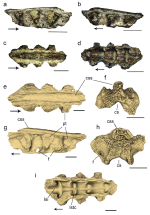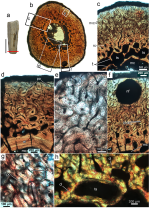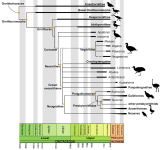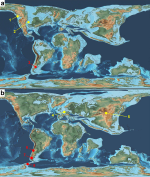albertonykus
Well-known member
de Souza, G.A., B.A. Bulak, M.B. Soares, J.M. Sayão, L.C. Weinschütz, A. Batezelli, and A.W.A. Kellner (2023)
The Cretaceous Neornithine record and new Vegaviidae specimens from the López de Bertodano Formation (Upper Maastrichthian) of Vega Island, Antarctic Peninsula
Anais da Academia Brasileira de Ciências 95: e20230802
doi: 10.1590/0001-3765202320230802
A worldwide revision of the Cretaceous record of Neornithes (crown birds) revealed that unambiguous neornithine taxa are extremely scarce, with only a few showing diagnostic features to be confidently assigned to that group. Here we report two new neornithine specimens from Vega Island (López de Bertodano Formation). The first is a synsacrum (MN 7832-V) that shows a complex pattern of transversal diverticula intercepting the canalis synsacri, as in extant neornithines. Micro-CT scanning revealed a camerate pattern of trabeculae typical of neornithines. It further shows the oldest occurrence of lumbosacral canals in Neornithes, which are related to a balance sensing system acting in the control of walking and perching. The second specimen (MN 7833-V) is a distal portion of a tarsometatarsus sharing with Vegavis iaai a straight apical border of the crista plantaris lateralis. Osteohistologically the tarsometatarsus shows a thick and highly vascularized cortex that lacks any growth marks, resembling Polarornis gregorii. The cortex is osteosclerotic as in other extinct and extant diving neornithines. These new specimens increase the occurrences of the Cretaceous avian material recovered from the Upper Cretaceous strata of the James Ross Sub-Basin, suggesting that a Vegaviidae-dominated avian assemblage was present in the Antarctic Peninsula during the upper Maastrichtian.
The Cretaceous Neornithine record and new Vegaviidae specimens from the López de Bertodano Formation (Upper Maastrichthian) of Vega Island, Antarctic Peninsula
Anais da Academia Brasileira de Ciências 95: e20230802
doi: 10.1590/0001-3765202320230802
A worldwide revision of the Cretaceous record of Neornithes (crown birds) revealed that unambiguous neornithine taxa are extremely scarce, with only a few showing diagnostic features to be confidently assigned to that group. Here we report two new neornithine specimens from Vega Island (López de Bertodano Formation). The first is a synsacrum (MN 7832-V) that shows a complex pattern of transversal diverticula intercepting the canalis synsacri, as in extant neornithines. Micro-CT scanning revealed a camerate pattern of trabeculae typical of neornithines. It further shows the oldest occurrence of lumbosacral canals in Neornithes, which are related to a balance sensing system acting in the control of walking and perching. The second specimen (MN 7833-V) is a distal portion of a tarsometatarsus sharing with Vegavis iaai a straight apical border of the crista plantaris lateralis. Osteohistologically the tarsometatarsus shows a thick and highly vascularized cortex that lacks any growth marks, resembling Polarornis gregorii. The cortex is osteosclerotic as in other extinct and extant diving neornithines. These new specimens increase the occurrences of the Cretaceous avian material recovered from the Upper Cretaceous strata of the James Ross Sub-Basin, suggesting that a Vegaviidae-dominated avian assemblage was present in the Antarctic Peninsula during the upper Maastrichtian.








